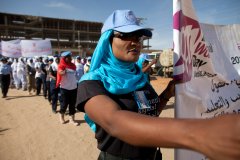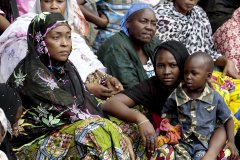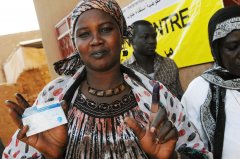Gender Issues Showlist
Women, Peace & Security
UNSCR 1325 calls on all parties to: protect and respect the rights of women and girls in conflict & post-conflict; increase women participation in all conflict resolution, peacekeeping and peace-building & to end impunity by prosecuting perpetrators of sexual and other violence on women and girls
index.php?option=com_content&view=category&id=56&Itemid=1913
Human Rights of Women
Thirty six years after the adoption of CEDAW, many women and girls still do not have equal opportunities to realize rights recognized by law. Women are denied the right to own property or inherit land. They face social exclusion, “honor killings”, FGM, trafficking, restricted mobility, early marriage,...
index.php?option=com_content&view=category&id=44&Itemid=1908
Violence Against Women
Violence against women is the most shameful human rights violation. Gender based violence not only violates human rights, but also hampers productivity, reduces human capital and undermines economic growth. It is estimated that up to 70 per cent of women experience violence in their lifetime
index.php?option=com_content&view=category&id=69&Itemid=1912
Political Participation & Leadership
Where women are fully represented, societies are more peaceful and stable. Women political participation is fundamental for gender equality and their representation in positions of leadership must be a priority for all Africans governments.
index.php?option=com_content&view=category&id=65&Itemid=1911
Latest News
- Chad: Parliamentary Elections 2024
- Namibia: General Elections 2024
- Mozambique: Parliamentary and Presidential Elections 2024
- Tunisia: Presidential Elections 2024
- MEWC is looking for Research & Communications Interns
- COTE D'IVOIRE: South-South Meeting to Promote Gender Equality and Combat Deforestation
- RWANDA: Rwanda Set to Launch Cervical Cancer Elimination Plan
- NIGERIA: Over 5,000 Nigerian Women Stranded in Iraq - Govt
- SUDAN: Healthcare Collapse Threatens Pregnant Women in Sudan's Sharg El Nil
- GHANA: President Nominates 12 More Ministers
ANALYSIS: Corruption in Kenya Drives Rise in Girl-Child Trafficking
Source: Women News Network
For almost three years, 39 year old, Jane Ngoyoini, has not seen or heard from her daughter. In 2007, 15 year old, Frieda Ngoyoini, completely vanished during a school girl-scout jamboree program near Chelmsford, Essex, Ireland. To date no one, including the police, has given her mother, Jane Ngoyoini, any answers or clues to the whereabouts of Frieda. As one of the missing girls that left for a sponsored trip to Ireland, Frieda has never been heard from again and has never returned.This disturbing special case, which has not reached the larger media, is still unsolved. It has left many questions unanswered. Child trafficking in Kenya is a daily occurrence, but police reports and actions to solve crimes are too many times non-existent.Allegations involving senior police officers and government officials in connection with possible bribery and cover-up activities with numerous child trafficking cases are now being examined closely in Kenya. In response to an alarming rise in the incidence in the trafficking of Kenyan children to Western Europe, women’s groups are now preparing to take Kenya’s government to court to find out who is culpable in the crimes.Human trafficking in Kenya is nothing new. The largest number of missing persons inside Kenya is girls. Most are younger than sixteen-years-of-age. Another disturbing portion of trafficked children are new-born babies. Even though mothers have asked for information about their missing children, numerous cases in missing babies continue to go unaddressed and unsolved by Kenyan authorities.“These are very serious situations and there are cases which the government has been reluctant to solve for many years,” said Mrs. Rukia Subow, National Chairperson for MYWO – the Maendeleo Ya Wanawake Organization, during a recent WNN interview. MYWO is one of the largest women’s organizations in Kenya that works to improve the quality of life in rural communities. They are especially focused on the women and youth of Kenya.Warning that MYWO will take imminent legal action against government authorities if any of the cases continue to be ignored, Rukia Subow states her case clearly. “The whereabouts of some girls have never been known till today, several years later,” she outlines.Under current Kenyan law, a missing person is considered dead if they have been missing for more than seven years. This law puts some missing girls out of the jurisdiction of legal protection after they have been missing the allotted time and declared dead as cases, if any case has been filed, are closed.In addition to MYWO - Maendeleo Ya Wanawake, numerous other women’s agencies in Kenya are also in the process of executing legal action against Kenyan authorities. The Federation of Women Lawyers, Society for the Advancement of Women Studies and the Single Mother Association of Kenya have initiated actions that highlight Kenya’s court system refusal to handle trafficking cases correctly.As part of a country-wide consortium, the Widows and Orphans Welfare Society of Kenya and the United Women Muslim Association have also hired attorneys to work on cases covering the growing crisis of child trafficking inside Kenya. “There are serious allegations we are investigating as a commission that some police officers and government officials have been involved in bribery,” said Florence Jaoko, a chair person with the Kenya National Commission on Human Rights.To date police have never released any formal report of the missing girls in Ireland since cases of five girls were first reported in 2007. Frieda Ngoyoini’s sixth case, which happened without official mention in the media, now continues without any investigative solution.“Confirmed reports show that most trafficked children are taken to the U.S and Western Europe,” adds Jaoko. “There were very high incidences last year and this month alone, there are 24 incidences of babies being sold to foreigners. Some children are sold for as little as just 24,000 shillings ($300).”While the government of Ireland has made some progress with cases of human trafficking since 2010, “The government did not report on any prevention measures targeted at reducing the vulnerability of unaccompanied foreign minors to trafficking,” said an April 5, 2011, “Trafficking in Persons Interim Assessment” report from the Office to Combat Trafficking in Persons at the U.S. Department of State .“Some girls are used as domestic house helps for many middle class and upper economic level families in the west. A lot more are used as sex workers. As trafficking in humans continues, the situation will worsen,” said Jaoko who is also a trained lawyer.Trafficking victims are often kidnapped or persuaded to leave from home locations and brought to other regions where they can be sold. “The majority of suspects involved in the trafficking process are nationals of the country where the trafficking process is occurring,” says the UNODC - United NationsOffice on Drugs and Crime in their 2006 Trafficking in Persons: Global Patterns report.In spite of current laws prohibiting illegal actions, teen-girl trafficking and the crime of trafficking infants and newborns in Kenya has been rising substantially inside the country. Many of the children, at least 75 percent of cases, involve baby girls who are less than 2 years-of-age. It is alleged that these infants are sold to childless or barren couples in Europe and America through a network of international traffickers.The Pumwani Maternity Hospital, operated by the City of Nairobi, was investigated for involvement in the 2004 theft of over twenty new-born babies who mysteriously disappeared from the hospital. During the investigation eighteen babies were discovered with adults that did not have matching DNA. With eighty to one hundred births daily, the spectre of human trafficking at the hospital is clearly troublesome. Missing babies are being taken from compromised mothers. Most trafficking targets are babies who’s mothers are living in extreme poverty. Others are from mothers who have died while giving birth.In addition to these “hard to manage” conditions, ongoing corruption within the police, judicial and administrative levels adds much to the daily problems. “Adoption Orders are issued by the High Court of Kenya only, and not any lower court. Once issued, the order is served on the Registrar-General (Marriages and Adoptions Office) for entry into the Adopted Children's Register and issuance of the Adoption Certificate,” says current regulations by the Office of the Attorney General for the Republic of Kenya.But legislation has not been upheld as newborn babies who are only a few days old have been illegally placed into the adoption pool in Kenya. “No arrangement shall be commenced for the adoption of a child unless the child is at least six weeks old and has been declared free for adoption by a registered adoption society in accordance with the rules prescribed in that behalf,” says the Kenyan Children’s Act 2001 [Section: 156(1)].As part of investigations, judicial transparency stating a child’s true age during adoption proceedings are needed. Early marriage, HIV/AIDS, lack of equality, extreme poverty and domestic violence contributes to situations that encourage mothers in Kenya to place newborn babies up for adoption.Other babies and newborns are taken from mothers without their permission or knowledge while a mother is recovering in the hospital after childbirth.Mothers who try to recover lost babies are already at a great disadvantage in the courts of Kenya, where judicial proceedings find that women, not men, who have children out of wedlock, hold exclusive full financial and parental responsibility for their children. “The Adoption Order must be accompanied by the original birth certificate of the child. In the case of abandoned babies, for whom no birth certificate is issued, documents from relevant authorities proving that the child was abandoned must accompany the Adoption Order. These may include a police report, Children's Department report and a letter from the children's home or hospital that held the abandoned baby,” continues the regulations made bythe Office of Kenya’s Attorney General.“Reports of children who disappear from hospitals immediately upon birth persist,” says a June 2010 report from the HccH – Hague Conference on Private International Law. Kenya Police Spokesman, Eric Kiraithe, confirms that there are daily complaints from the public against police receiving bribes to cover-up crimes. To combat the problems those who have been found guilty have lost their jobs; as well as served time in jail for misconduct.“The police force has improved over the years,” says Kiraithe. “Police reforms have played a big role towards improvement of services and security. The pay package for police officers has risen by more than 120 percent since 2003. However, there are still a few rogue officers in the force and we deal with them accordingly,” added Kiraithe. “It is obvious bribes are given for one to cover-up crimes meant to avoid prosecution and jail time.”Kenyan Intelligence reports also say that some judicial officers from time to time have been receiving substantial kickbacks from traffickers in a move aimed at acquitting them from blame.“Corruption as we know is a big problem in this country and it will remain so for a long time,” says Samson Munywoki a sociology lecturer at the United States International University in Nairobi. “With money you can buy anything in this country. One can buy justice when you have done wrong. There are murderers who bribe both judges and police, it’s a serious issue.”Trafficking of humans is now becoming one of the most common crimes in Kenya. The situation has put the country in a vulnerable position. As a major transit point for international travel, trafficking rings have targeted many of the weakest people in Kenyan society.“Child trafficking is ripe,” continued Jaoko. “Newborn babies go missing in Kenyan hospitals each month since 2009,” she added. “These are serious allegations.”





